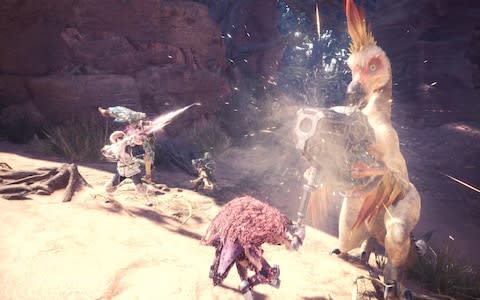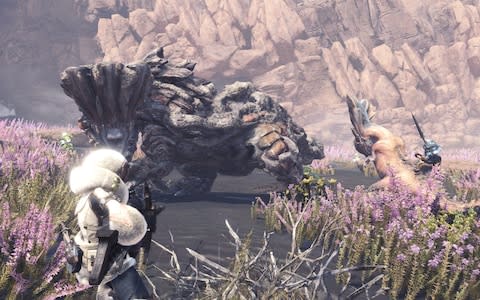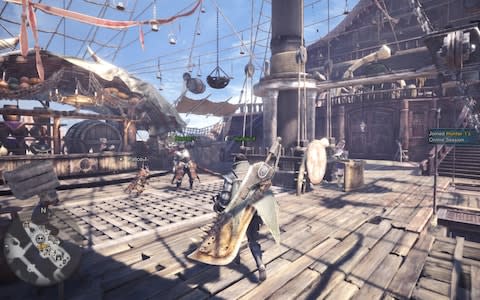Monster Hunter: World preview | What we learnt from the first ten hours of Capcom’s beastly adventure

For those familiar with Capcom’s sprawling fantasy adventure, Monster Hunter: World is going to be a little different from what you are used to. The Japanese phenomenon heralded its wooing of the West by breaking cover with this new game at E3 2017, rather than its traditional home nation reveal.
Monster Hunter has always held a special place in the hearts of many, building a cult following around the globe. But it has never quite broken the mainstream, away from home at least, and World is a clear, concerted effort to change that.
It has moved away from handheld to the connected home machines of PS4, Xbox One and PC. It is bigger, bolshier, always online and looking to make good on its promise of attracting a new breed of audience. Can it succeed? Time will tell. But both the intrigued and the experienced can rest easy on one thing, it is also making its play by being an extremely good video game.
Sitting down with Monster Hunter: World for its opening dozen hours at Capcom’s offices in Osaka, you realise that the famous Japanese developer is presenting its latest entry with a degree of confidence and swagger. This comes from a definable shedding of some of Monster Hunter’s excess baggage and less endearing idiosyncrasies. Series producer Ryozo Tsujimoto has said the team has ‘reviewed and revisited key design decisions’ in order to build this latest entry. The shift shows and it is to the benefit of newcomers and old hands alike.
It wastes little time
Within moments of creating your hunter, an ‘A-lister’ of the Fifth Order of the Commission, you are already pitched into a cracking set-piece. This ragtag bunch of hunters and scholars are on their way to the ‘New World’ to find new habitats and chart their ecology aboard a ship. Which gets unceremoniously dumped out of the water by a giant volcano rising from the water. Rude. Your hunter and your handler scramble across the overturning ship, clambering up the decks in a neat showcase of the game’s more nimble maneuvering.
This kind of hot opening isn’t necessarily unfamiliar to Monster Hunter players, but often that momentum can be checked by your first quests: collect x amount of herbs, swipe at docile vegetarian Aptonoths for a while. Not here. Once you select your weapon and tool up your Palico cat companion at the Astera base camp you are straight on an expedition, tracking and hunting Great Jagras in the depths of the lush Ancient Forest. As a player intrigued by Monster Hunter but consistently put off by the plodding openings, this immediate gratification was the most welcome change.

Complexity remains but accessibility improves
Also much improved is the way Monster Hunter’s unique quirks are either better explained or streamlined. It is in the smallest and most overdue things; like being able to drink a healing potion while moving or the game automatically sheathing your weapon when you are trying to use a different item. But in a broader sense, everything is much better explained. As you explore Astera, you are given plenty of instruction on what to do, where to go and how to improve your gear at the Smithy by farming monster parts. Buff your stats with a meal. Practice at the arena. It never feels like hand-holding, just more smartly guided.
It means that Monster Hunter can retain most of its complexity, but simply opens it up for newer players. “We don’t want to get rid of the meaty challenge that fans want from the game but we recognised that the difficulty curve was rather extreme,” says director Yuya Tokuda. “We’ve rebalanced that into a smoother introduction, a smoother ramp into the game, so that everyone has a chance to get as far into the game as they want to.”
This extends into the field. You now have a trail of glowing ‘scoutflies’ to guide you to your next objective is you choose to do so, helping you tracks monsters by nudging you towards footprints and other telltale signs. The more info you gather, the better you become at chasing down a particular beast.
- A scene from Fifa 18
09 Dec 2017,7:00am
Comment: It’s time children were taught some serious practical skills... like how to win at Fifa 18
Premium
Flexibility with your weapons, too, is a significant change. While you can only take one weapon with you at a time, you can now change it up at your site camp rather than returning to Astera. So if you are struggling with a speedy monster when waving your massive Great Sword around, you can nip back to your tent and pick up something with a bit more agility.

Combat is slicker and weapons are still gloriously ridiculous
Speaking of which, I became rather fond of my Charge Blade, a fabulous contraption which can be held in two hands as a sword and shield or snapped together to form one hulking axe. It could also zap monsters with an electrical elemental blast when fully charged. It is, as many Hunters will know, one of 14 different types of weapon. From the reliable long sword, to dual blades, to ranged bowguns there are plenty of options to find a style that suits you.
I liked the flexibility of the quicker dual-wielding with the option of cracking out a bigger weapon to go in for the kill. The combat is still definably Monster Hunter --that slower, carefully measured battling that is also the realm of Dark Souls and Bloodborne-- only significantly slicker. It feels heavy and deliberate in the hands, with you needing to carefully judge swings and your movements to fight off the bigger beasts. Feedback is excellent too, with the animation of the monsters reacting viscerally to good hits and telegraphing their own attacks.
While each weapon is able to see off any monster in the right hands, Tokuda says that switching up against different types of monster is also a viable tactic, particularly you can now change gear at camp. “Say you have a fast moving monster darting around, it’s going to be more difficult with the great sword as it will take a long time for your attacks to build up,” he says. “Choose something like the dual blades or even a ranged weapon then you might be able to get a fix on the fast monster.”

The ecosystems are fascinating and gorgeous
These various beasts are beautifully designed, from the naturalistic, dinosaur-esque Aptonoths and Anjonaths; to the weird, feathered, thick-tongued bulbosity of the Pukei-Pukei; to the vast, fantastical majesty of the Elder Dragon Zorah Magdaros, World’s flagship monster. The art team tell us that naturalism is important, but they also take inspiration from other things in the world as far reaching as cars and steam hammers. The result is a fascinating bestiary that has never looked better.
They take their place in open maps with their own ecosystem. Tokuda describes each ecosystem as a ‘pyramid’, with the largest monster at the top of the food chain and each level featuring other carnivores, herbivores and, of course, the flora that the more docile creatures can munch on. The two maps that we got to play were significantly different, the lush foliage and verticality of the ancient forest and the wider, altogether more soggy wasteland. Both were beautiful in their own way and the monster within fit into their surroundings. One of the more impressive things about Monster Hunter: World is to stand back and watch the monsters interact with the other. To see king of the jungle Anjonath come stomping down on Pukei-Pukei before the latter flies away in fear is quite the thing. And this interaction stretches down Tokuda’s pyramid.
It seems somewhat curious to be eulogising a game like Monster Hunter: World for finally opening up its maps, when vast open-world game have been in vogue for a while. However, it is important because it significantly changes the behaviour of the monsters and yourself. Now you can chase or be chased across an entire map, swinging from vines to try and keep up with fleeing prey or sprinting away from a stomping behemoth without the safety of ‘area boundaries’ to let you hide away.

Online is consistent and fully-integrated
It also opens up the game to let larger hunting parties explore maps together. While connected local and online play has long been part of Monster Hunter, solo and multiplayer has been kept separate. In World you can team up in hunting parties of up to four players, team up and take on all of the beasts and quests of the main story. You can also send up ‘flares’ when struggling with a monster alone to call in help from other players. There is little as satisfying as a well-coordinated and clean hunt with a group of friends.
While Tsujimoto has said that Monster Hunter: World won’t have a game-as-a-service type blueprint in the vein of Destiny, there will be a host of features that will take advantage of the fact that the majority of its players will be constantly connected. Daily rewards, time limited event quests and, of course, more expansive downloadable content will all be on the table to keep hunters coming back.
Monster Hunter: World Where To Buy
Given the improvements and newfound ease of which Monster Hunter: World sucks you into its vistas, that seems highly likely. Whether it can stretch that out into the mainstream success is so clearly craves remains to be seen, but it has given itself a fearsome fighting chance.
